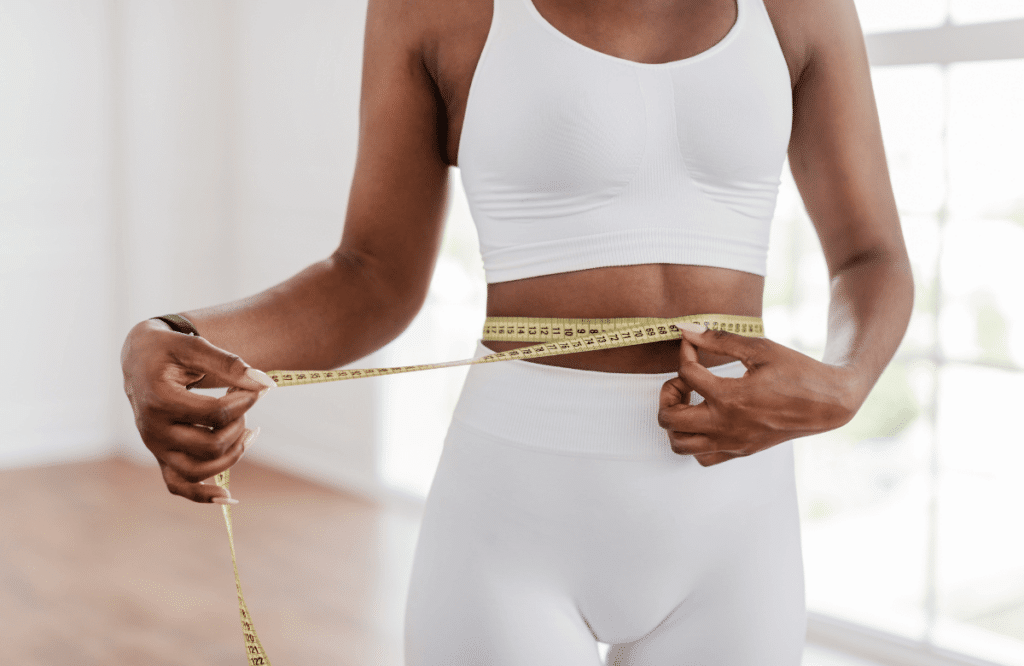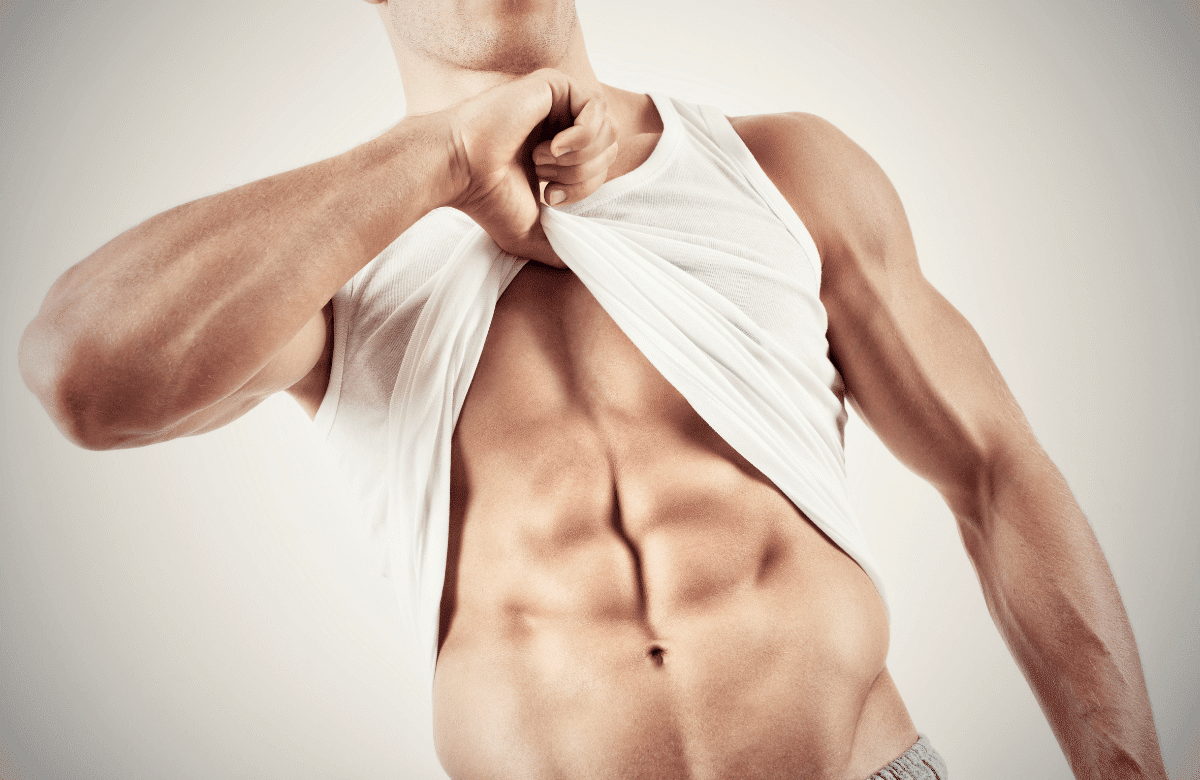Dreaming of a toned, sculpted stomach? You’re not alone. But how long does it REALLY take to get a six-pack? Let’s cut through the myths and find out.
Anyone can get a six-pack – the question is, how long will YOUR journey take? This article reveals the secrets to shedding fat and revealing your abs.
We’ll cover everything from the right diet to the most effective workouts. Get ready to transform your body!
Jump to:
How Do You Get Six-Pack Abs?
You’ve probably heard the phrase, “Abs are made in the kitchen.” But this isn’t just an idiom or platitude—anyone is capable of achieving six-pack abs, as we all have the required muscles.
The primary muscle in the abdomen behind a chiseled six-pack is the rectus abdominis. This abdominal muscle is a long, flat band of fibers extending vertically from the pubic bone to underneath the ribs.
The rectus abdominis is divided, with the right and left sides running parallel to each other. Each side is divided into three segments and is what provides the sought-after six-pack appearance.
Training the abdominal muscles can give you a strong core, but it won’t be enough on its own to reveal six-pack muscles. The only way to reveal the abdominal muscles is to lose body fat levels.
What Body Fat Percentage Are Abs Visible?
To reveal the core muscles and achieve the perfect beach bod, you will need to shed layers of fat, typically through a calorie deficit.
The body fat percentage required to see six-pack abs ranges between 14–20% for women and 6–14% for men.
That said, the ideal body fat percentage will vary from person to person. Factors like body type, where you store fat, and your exercise routine will play a significant role. Some individuals see their abs at higher body fat levels, while others need to lose a bit more.

How Long Does It Take To Get A 6 Pack Abs?
The question on everyone’s mind is, “How long does it take to get a 6 pack?”
Unfortunately, reducing your body fat levels doesn’t happen overnight and can be a long, daunting process.
The American Council on Exercise claims losing 1% body fat per month is safe and manageable.
The average woman in the United States has around 40% body fat, while the average man carries about 28%. Women naturally carry more body fat because they have more estrogen.
With these numbers in mind, the average woman would need 20–26 months to reach 14–20% body fat. It would take the average man roughly 14–20 months to get the target body fat percentages for six-pack abs.
Factors Affecting the Journey to a 6 Pack
There are countless factors besides your current body fat percentage that affect the timeframe it takes to get visible abs. Fortunately, some of these factors are within your control, like diet, rest, and workout programs.
Sex, Age, and Genetics
Unfortunately, some factors that affect weight loss are outside of your control.
Sex, age, and genetic disposition all play a role in the time it takes to lose body fat. Other factors like physical disabilities, hormones, medical conditions, and medications can affect the speed as well.
For example, some individuals burn more calories throughout the day from subconscious behaviors, like fidgeting and moving around.
Other elements, like living in an environment with poor food choices or a lack of education on healthy diets, can make it difficult to shed body weight.
What’s the good news?
The same strategies, techniques, and resources will work for you whether you’ve been gifted by the genetic gods or not.

Current Fitness Level and Body Composition
One of the primary factors that affect the time it takes to lose weight is your current body weight and exercise habits. As you can imagine, if you start at a lower body fat percentage and have healthy exercise habits, you will achieve your goal faster.
However, some aspects like body shapes, where you store fat, and lean muscle mass will also play a role in the time it takes to lose weight.
Diet and Nutrition
As mentioned earlier, “abs are made in the kitchen.”
Your daily diet and nutrition plan will impact the timeframe it takes to achieve visible abs. This is because abs become visible after you lose a certain amount of fat or body weight. Your daily calorie intake, diet adherence, and macro ranges play a role in the time it takes.
For example, eating a balanced diet of healthy foods and lean proteins will provide your body with more nutrients than eating a low-calorie diet of junk food. It’s also essential to get enough protein so your body is less likely to lose lean muscle mass.
Training and Exercise Routine
The type of strength training, cardio exercises, and physical activity you engage in will impact how quickly you achieve your fitness goals. The frequency also affects the timeframe. Although any form of training will be better than none, some options may be a bit more effective.
High-intensity intermittent exercises (HIIT) may be more effective than standard aerobic exercise. Incorporating some form of resistance training may also help you reach your weight loss goals faster than just cardio exercises.
Rest and Recovery
If you’re too tired from all the high-intensity exercise, how will you continue to lose weight or handle food cravings?
Rest and recovery are critical for any workout plan, but especially if you’re trying to lose weight. Your body is likely in a caloric deficit, meaning it’s burning more calories than it needs for maintenance.
A caloric deficit can lead to fatigue or injury, especially if you aren’t using the best practices. That’s why it’s essential to get enough rest and give your body a break when it needs it. This may be in the form of rest days from the gym, cheat meals, or getting enough sleep.

The Timeframe for Visible Abs
Here’s an estimated timeframe it will take to achieve visible abs based on reaching roughly 10% body fat.
Remember this is only an estimate, and several factors will impact your timeframe and approach to your fitness goals.
Over 25% Body Fat
It may take the average man 1–2 years to reach 10% body fat if they fall into this body fat range. In these cases, it’s best to prioritize learning the basics of healthy eating, nutrition, and exercise.
- Take time to learn the basics of healthy eating, nutrition, and fitness.
- Start small and focus on making changes with a significant impact—like changing your diet.
- Set realistic goals and stay positive.
Developing a solid foundation will help you use the right strategies and develop healthy habits early on. This will carry you into the rest of your training and weight loss journey, making the process easier.
Between 18-25% Body Fat
It may be possible to achieve visible abs within 6–12 months if you fall into this range. Like the previous level, it’s still critical to learn the basics of healthy eating, nutrition, and fitness. That said, you might need to prioritize switching your habits rather than learning new ones.
- Determine which habits aren’t working for you and develop a strategy to mitigate them.
- Create a long-term plan for 6–12 months with achievable goals.
- Use a healthy diet plan that works for your tastes, but ensure it stays within your macro and calorie ranges.
You might need to reduce certain habits, like snacking late at night or selecting high-calorie choices when eating out. It’s essential to create a long-term plan with achievable milestones so you can progress at a consistent pace.
Lastly, switching to a healthy diet that includes your preferences, calories, and macronutrients will ensure you meet your goal in a timely manner.

Between 14-18% Body Fat
It may only take you 3–6 months to achieve visible abs if your current body fat percentage is 14–18%. You may already have healthy fitness and diet habits if you fall into this range. If that’s the case, you can make slight adjustments to suit your fitness goals.
- Consider meal prepping to hit your calorie and macro requirements more efficiently.
- Ensure your diet is nutrient dense with lots of protein.
- Track your workouts and diet to have an accurate measurement of your progress.
Depending on your fitness level, you may only need to make slight adjustments or kick things up a notch. That said, you may also need to learn the basics of nutrition, calorie counting, macronutrients, and fitness regimens.
Under 14% Body Fat
It may only take you 1–3 months to achieve visible abs if you fall into this range. You probably already have healthy habits in place, so you may need to tighten your diet plan, fitness regimen, and discipline.
- Dial in your calorie and macronutrients for 4–12 weeks, depending on your current body status.
- Eliminate eating out, alcohol, and cheat meals.
- Maintain consistency with your diet and exercise protocols.
Don’t forget to include rest and recovery. You may need to prioritize relaxation or sleep to reduce stress. Otherwise, maintain consistency and discipline, as you’re sure to reach your goal in no time.

Tips to Get 6-Pack Abs
Obtaining sculpted 6-pack abs requires major lifestyle shifts for most individuals. Adjusting your diet, activity levels, sleep schedule, and other factors may be necessary to hit your fitness goal. Fortunately, you can use the following lifestyle tips to make the process easier.
Calculate Your Calories and Macronutrients
Visible abs require you to reduce your body fat percentage. One of the most critical factors in accomplishing this is controlling your calorie and macronutrient intake.
Calculating your daily caloric needs based on your weight, height, age, and activity level will give you a better understanding of how many calories you should consume to achieve your goal.
Macronutrients, like protein, carbohydrates, and fats, play distinct roles in your diet. Aim for a moderate carbohydrate intake while emphasizing high-quality protein sources and healthy fats.
Online calculators can help you determine your target caloric intake and macronutrients.
Increase Your Protein Intake
Protein is a vital component for building and repairing muscles. It also plays a crucial role in maintaining a lean physique. To promote muscle growth and recovery, increase your protein intake.
Include lean sources of protein such as chicken breast, turkey, fish, lean cuts of beef, tofu, and legumes in your diet. Additionally, consider incorporating protein supplements like whey protein or plant-based alternatives if needed.
Use High-Intensity Training Sessions
While diet plays a significant role in revealing your abs, incorporating effective workouts is equally crucial. High-intensity training sessions, such as interval training or circuit training, can help you burn calories and increase your metabolic rate.
These types of workouts involve short bursts of intense exercises followed by brief periods of rest. They are efficient at burning fat, including the stubborn abdominal fat that covers your abs.
Including compound exercises like squats and deadlifts in your training routine engages multiple muscle groups, helping you burn more calories. Additionally, incorporating activities that directly target your abdominal muscles, such as planks or crunches, can strengthen your core and enhance the appearance of your abs.
Get Enough Sleep
Ample rest and recovery are often overlooked factors when it comes to achieving 6-pack abs. Sleep plays a crucial role in regulating hormonal functions, including those involved in metabolism and muscle growth.
Aim for 7-9 hours of quality sleep each night to optimize your body’s recovery and overall well-being.
Insufficient sleep can lead to increased hunger and cravings for unhealthy foods, making it harder to stick to your diet plan. It can also impair your cognitive function and energy levels, affecting the quality and intensity of your workouts.

How to Track Your Progress
Tracking your progress is critical for achieving your weight loss goals. Without an accurate measurement of where you’re at, you won’t know if you’re heading in the right direction or not. But what are the best methods for tracking your weight loss and fitness progress?
Consistent Daily Weigh-Ins
One of the easiest ways to track your weight loss process is consistent daily weigh-ins. Consistent and daily are the keywords here.
It’s important to weigh yourself at the same time, on the same scale, and in the same type of clothing every time.
This removes variables like water retention or food digestion, ensuring you have an accurate reading of your current weight.
The most recommended timeframe is first thing in the morning after you use the restroom. This will give you an accurate reading, as you haven’t had anything to eat or drink yet. You can also weigh yourself a second time before bed for more data on how your weight fluctuates.
Don’t forget to keep track of your weight, whether it’s in a journal, excel sheet, or on your phone.
Use Food Tracking Apps
Another way to track your progress is through calorie-counting apps like MyFitnessPal or LoseIt. These mobile apps allow you to record the different foods or drinks you had in the day, helping you keep track of the calories and macronutrients.
This will help you understand if your diet is on pace with your calorie deficit or if you’re eating too much or too little.
Many of these apps are free, but they also have paid subscriptions with advanced features like barcode scanning, recipes, and more.

Take Progress Photos
Another way to keep track of your development is to take progress photos and optional body measurements. Numbers on the scale or increases on the treadmill don’t always offer a clear picture of improvement.
Having a visual representation of how far you’ve come can help you stay motivated and continue your journey.
For example, you might take a photo before you begin your journey and continue to take pictures at significant milestones, like the 4-week, 3-month, 6-month mark, and so on. It’s essential to use similar poses, lighting, and clothing in every photo shoot to ensure consistency.
Body measurements or looking at old clothing that used to fit can also serve as a way to track your progress and stay motivated.
Frequently Asked Questions (FAQ)
How Fast Can I Get a Six-Pack?
The timeframe will vary depending on your current body fat percentage, fitness habits, and more. That said, most individuals can lose 1 percent of body fat per month. It may take the average American woman 20-26 months and the average man 15-21 months.
Is It Possible to Get a Six-Pack In 30 Days?
Although possible, it’s highly unlikely to achieve a six-pack in 30 days. You would already need to be close to the body fat percentage required for visible abs. 30-day ab challenge workouts can help you lose weight and gain muscle mass, but it may take longer for visible abs.
What % Body Fat Percentage is Needed to Reveal Your Abs?
Six-pack abs require a relatively lean and athletic physique. Men need around 6–14% body fat for visible abs, while women need approximately 14–20% body fat levels. Women naturally carry more fat, as they have more estrogen than men.















